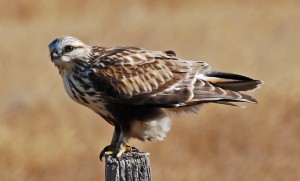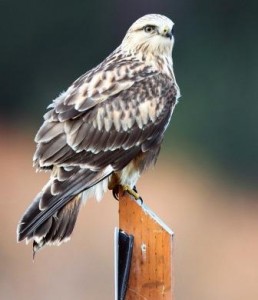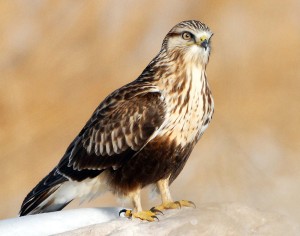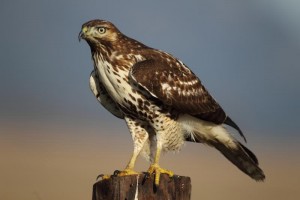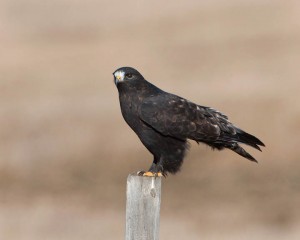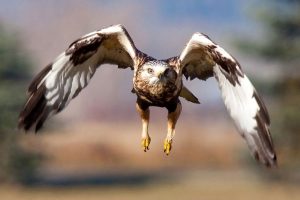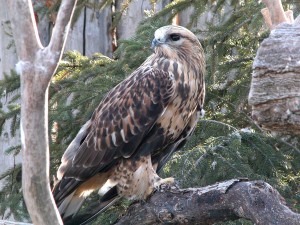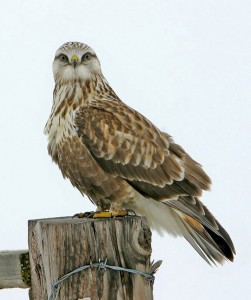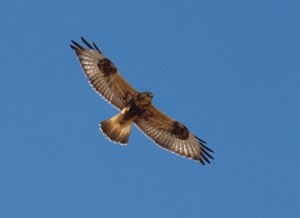Rough-Legged Hawk
Rough-legged hawk, formerly called the rough-legged falcon, is a moderately large, migratory bird of prey that spends the summer in the Arctic as well as the Subarctic regions, moving south to avoid harsh winters. As compared to its Buteo cousins, including the ferruginous hawk and the red-tailed hawk, the rough-legged raptors can be identified by their smaller bills, broader wings with wide wingtips, and a longer tail.
Scientific Classification
| Kingdom | Animalia |
| Phylum | Chordata |
| Class | Aves |
| Order | Falconiformes or Accipitriformes |
| Family | Accipitridae |
| Genus | Buteo |
| Scientific Name | Buteo lagopus |
Quick Information
| Other Names | Rough-legged buzzard, Roughleg, Ratonero calzado (Spanish), Buse pattue (French) |
| Size | 18-24 inches (46-60 cm) |
| Wingspan | 13-17 inches (33-43 cm) |
| Weight | 1.32-3.66 lb (600-1,660 g) |
| Color | Two forms are seen – a dark morph rough-legged hawk is dark brown with light trailing edges underneath its wings; a light morph bird has dark blotches at the bend of its wing and white under-wings; female birds show light-colored heads with dark patches at the underparts while the males have a more mottled pattern |
| Distribution | Tundra and taiga regions of Eurasia and North America in summer; North American individuals move into central, northeast, and western United States and southern Canada while the Eurasian roughlegs move to Asia and southern Europe |
| Habitat | Agricultural regions, plains, marshlands, open fields, and prairies in winter; boreal forests, treeless tundra and alpine regions |
| Sound/Song | Loud and soft whistles with a descending pitch; has a long, drawn-out call; nesting adults produce a cat-like mew and use it as an alarm call repeating it every 30 seconds or so; while courtship uses a low-pitched whistle, which changes into a hissing sound |
| Lifespan | Over 18 years |
| Diet | Rodents including voles, mice, shrews, and lemmings; medium-sized mammals such as pocket gophers, young hares, and arctic ground squirrels; birds such as Lapland Longspurs, short-eared owls, shorebirds, waterfowl, ptarmigan, American tree sparrow, and snow buntings; occasionally steals food from other birds of prey or eats carrion |
| Adaptations | Its legs are feathered to its toes, which help in keeping warm in the very cold arctic range; its superb eyesight helps to spot prey from a great height and capture it with high precision |
| Size of Clutch | 1 to 7 eggs |
| Egg Size | Length: 5.3-6 cm Width: 4.2-4.8 cm |
| Number of Broods | Single brood a year |
| Incubation Period | 31 to 37 days |
| Predation and Competition | Eggs and nestlings are preyed upon by wolverines, brown bears, arctic foxes, great horned owls, snowy owls, golden eagles, and falcons |
| IUCN Conservation Status | Least Concern |
Behavior
The rough-legged hawks are mostly crepuscular, which means they are active at dawn and dusk. However, some of these keen hunters are also spotted during the day. These birds are often seen perched alone in trees, on telephone poles and fence posts, or soaring in the sky with a smooth continuous motion and scanning a grassy region or an open field for prey. Once they spot the prey, the hawks circle above several times before pouncing on it and striking it with their talons. They are quite territorial and do not usually form flocks, roosting alone at night.
Mating and Reproduction
A rough-legged hawk has a monogamous mating system. It migrates alone and finds its partner after reaching its breeding range. Courtship displays are performed during the late winter when the flying conditions slightly improve. A male hawk flies aloft and makes a whistling call until a female is attracted. The males are also known to make a “sky dance” that involves soaring high up into the air, sudden diving, and stalling in midair. Moreover, a male engages in conflicts with rival male hawks in order to defend its breeding territory as well as its partner.
These birds generally breed during April-June but in few cases breeding has also occurred in July. The female rough-legged hawks build nests on rocky reefs and cliffs using materials such as molted feathers, twigs, and grass, which are mostly carried by the males. Nests are quite large with a height of 9.8-23.6 inches and diameter of 24-35 inches, taking 3-4 weeks to build.
Life Cycle
Once the eggs hatch, the female remains with the hatchlings and feeds them food that is brought by the male. The juvenile birds are ready for their first flight at 4-6 weeks after hatching. However, the fledglings are fed by their parents for another 2-4 weeks, and they become fully independent at 55-70 days old. Both the male and female birds reach sexual maturity at 2-3 years.
Interesting Facts
- This American raptor is named “rough-legged hawk” for the extensive feathering on its legs. In fact, it is one of the few hawk species in America to have feathers on its toes.
- In addition to other materials, these birds may construct their nests with caribou bones.
- The rough-legged hawk nestlings have large food requirements. Between hatching and fledging, a group of two young birds needs 26 lbs of food to support their rapid growth.
References
- https://en.wikipedia.org/wiki/Rough-legged_buzzard
- https://www.allaboutbirds.org/guide/Rough-legged_Hawk/id
- https://www.audubon.org/field-guide/bird/rough-legged-hawk
- https://www.rspb.org.uk/birds-and-wildlife/wildlife-guides/bird-a-z/rough-legged-buzzard/
- http://animaldiversity.org/accounts/Buteo_lagopus/
Published on March 14th 2016 by admin under Coniferous Forest Animals.
Article was last reviewed on 5th December 2024.


